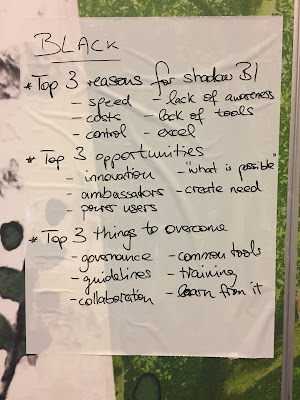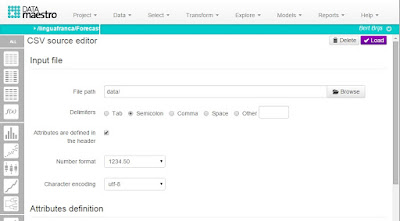In this
series of three posts, I will address some typical aspects of programme
management for decision support. The first post will define programme and project
management in Business Intelligence (BI) and its relationship with IT
architecture.
The second
post will deal with some issues in governance, the tensions that arise between
business and IT and how to deal with them.
The third
post will propose a new way of designing systems for both transaction and decision support to improve the
organisation’s effectiveness further.
A project holds the middle ground between routine and improvisation to
produce a product
This is the
essence of project management: managing unknown and unfamiliar risks and
uncertainties using experience with proxies and lessons learnt to produce
something within a time frame, a budget and within a certain quality range
while delivering correct management information for the steering committee
about the progress and the resources needed.
In Business
Intelligence, this product orientation sometimes leads to overly focussing on
the deliverables while ignoring valuable opportunities along the way. Many BI
projects are described in terms of delivering x reports on y KPIs or delivering
OLAP cubes and reports on x sources to describe what I call “stocks and flows”
of business processes. I am not arguing against this approach but project
steering committees should be aware that a tunnel vision can be a costly
liability in BI.
Already in
1994, Séan Kelly (not the Irish cyclist nor the politician, but the
datawarehouse manager from Eireann Telecom) stated that the business user can’t
formulate correct requirements at the start of the BI project and changes these
requirements during the project’s lifecycle. Twenty years later, many BI
project teams haven’t learned anything from Kelly’s observation. Either they
stick to the initial product description or they reiterate the analysis –design
–build cycle at extra cost and throughput time. The major reasons are a lack of
BI maturity in the organisation and the lack of an overall BI programme vision,
at best an incomplete one. In the next
section I describe BI programme management and how this contributes to more
effective BI projects.
Projects deliver products,
programmes have outcomes
There is
certainly some truth in this dictum on one condition: BI programme management
should focus on favourable outcomes for decision making. The BI programmes can
focus on improving decision making processes, on information objects like
customer, product, channel or on broader outcomes like knowledge sharing, improved
positioning, improved competitive capabilities etc.
The
decision on the programme scope is not trivial. Sometimes programmes can define
too broad an objective for the organisation’s maturity. Not everyone sees the
relationship between a new column store and improved competitive positioning.
Some
authors and practitioners see a BI programme as a collection of projects, a
higher hierarchical level from tasks via projects to programmes. I strongly
disagree. In my experience, BI programmes have links with other programmes on
HR, IT infrastructure, marketing and sales, and other functional or strategic
endeavours to produce a better outcome for the BI project portfolio.
The matrix
below shows a few examples of how BI programme management interacts with other
business programmes in the organisation.
Functional strategies and programmes
|
BI Programme interaction
|
Dependencies outside the BI programme
|
Marketing:
improving customer knowledge
|
CRM
and ERP systems deliver data to the customer analytics programme
|
The
organisational question of customer ownership needs to be addressed when
multiple divisions deal with the same customer.
|
Marketing:
improving direct communication response rates
|
A customer MDM
programme is initiated to improve data quality for BI and CRM processes
|
The customer logging
processes,( e.g. in the contact centre) needs improvement initiatives
|
Finance:
reducing days receivable outstanding
|
Within
the customer analytics programme, a data mining project is initiated to
predict payment behaviour
|
The
invoicing process needs updating
|
HR:
reducing absenteeism
|
HR and ERP systems
deliver data about potential influencers on absenteeism as well as customer
analytics to examine the impact of customer behaviour on absenteeism
|
The organisation’s
management style needs adjustment for the new economy
|
Table 1 How BI Programmes interact with other business
programmes
From these
simple examples you can see clearly that the outcome of a BI programme affects
other programmes and in its turn is affected by other programmes. In the case
of BI projects we can also distinguish dependencies with other projects but
these dependencies are usually smaller in scope and easier to manage in the
steering committee. You will probably
recognize some of these quotes:
I can’t get the data from the HR department,
it’s classified information,
They say I have to take the matter to the
architecture board,
The infrastructure needs upgrading,
The license negotiations are slowing down the
project, etc…
Now that the
link with external programmes is clear it is high time to look what is inside a
BI programme. This is where the link with architecture becomes clear.
BI
programmes should have an overarching view, vision, business case and target
setting for the principal contributors to better decision making.
In Kimball
terms: the conformed dimensions, in Linstedt terms: the data vault’s hubs and
satellites. No matter which solution approach you choose, a vision on the
principal information objects is quintessential to the success of individual BI
projects.
From Information Objects
to BI Architecture
Thinking
about information objects like customer,
channel, product, location, is
thinking about the way they are created, stored, updated and deleted in the
various information systems of the organisation. It also relates to the
business processes using these information objects to produce context for
transaction registrations like information
request, complaint, order, payment etc..
Thus,
answering the what, where, why and how questions as the Zachman Framework does
is talking architecture. The illustration below is a classical BI situation.
With the advent of complex event processing and big data technology on Hadoop,
things are changing but for 99% of the organisations, classical BI is still the
modus operandi.
Figure 1 A generic architecture of contemporary
information systems: transaction systems and decision support systems are
separated systems where information objects pass from the transaction systems
to the decision support systems via an Extract Transform and Load Process.
Some
comments with the above schema in Archimate modelling language:
Business
drivers such as “end to end support for the order to pay process” define
various business processes which in turn are supported by transaction
registration systems. These systems create transaction lines like order, order
confirmation, bill of material, manufacturing data, shipping bill, delivery
note, customer receipt registration, invoice,
customer payment registration etc…
All these
transactions relate to information objects like date and time, product,
customer, shipment mode, etc..
Via the
Extract Transform and Load process these objects are scrubbed, normalised and
made ready for publishing in analytical environments and reports. That’s when
they become decisional data objects: facts and dimensions are always the end
result, no matter what intermediate storage you use: a data vault, an anchor
model or an enterprise data warehouse in the third normal form. The facts are
the measures in the reports and the dimensions are the perspectives on these
measures. Usually you read the facts per dimension, i.e. the sales per region,
per outlet, per account manager,…
In data
mining projects the facts and dimensions will be flattened in a matrix for
offline analysis and combined with semi structured and unstructured data in
Hadoop files systems. In streaming analytics temporary snapshots are compared
with the scoring model which is derived from the facts and dimensions as well
as semi structured and unstructured data in Hadoop file systems.
With new
Big Data technologies, new architectures will emerge but that is for another
post.
Suffice it to
conclude that managing enterprise wide facts and dimensions as well as semi
structured and unstructured data is both the task of programme management and
BI architecture.
BI Architecture and Programme Management: See the Picture
Programme
managers need to see the entire picture to set priorities, look for synergy
between projects and initiate data management projects to fill the gaps between
the BI projects as required by the business.
An example can make this clear.
Let’s take
the first example from table 1: “Improving Customer Knowledge” driving a
programme to consolidate all static and dynamic information about customers and
their behaviour.
Conferring
with the enterprise architecture board, the programme manager discovers that
the geographical coordinates of each customer are valuable information for the
logistics department to optimise delivery schedules. Though it is outside the
scope of marketing, the programme manager will initiate a project to add
geolocation data to the customer dimension. Later in the process, the marketing
manager discovers the potential of geomarketing.
Of course,
the interaction can also work the other way around: the BI architecture review
board evaluates programmes and projects and readjusts priorities and project
scope on the basis of availability and cost of data capture. Sometimes the
replacement or adjustment of a source system can impact the BI programme
heavily. It always boils down to defining a business case that sticks. Excuse
me for hitting the nail over and over but it all starts with business analysis
for business intelligence that sets the scene. Too many projects and programmes
have failed in BI because of a gung ho approach of the designers and builders
who cannot wait till the specs are thought through after thorough analysis of
the strategy process and the data landscape.





